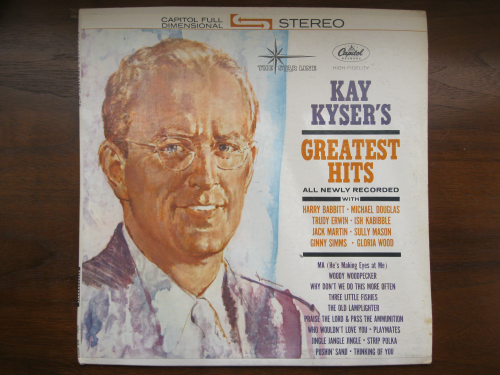
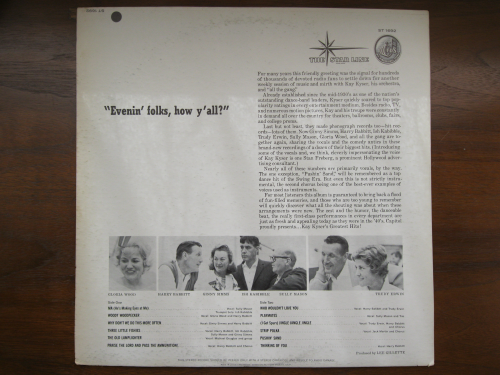

Song: Praise the Lord and Pass the Ammunition! / Jingle Jangle Jingle
Artist: Former members of Kay Kyser’s band - vocals by Harry Babbitt and Chorus
Conductor: Billy May (uncredited)
Record Album: Kay Kyser’s Greatest Hits
Record Label: Capitol Records ST 1692
Recorded: August 25, 1961
Released: 1962
Location: Appalachia Radio
Note: This stereo record features a very hard panning of the instruments and
vocals. The female vocals, tambourine, and saxophones are
on the left. The male vocals, percussion, trumpets, and
trombones are on the right. More modern mixes have reduced this effect
to be more centered.
From Julie’s perspective, this song will be about 160 years old. We just happen to be at the halfway mark right now.
I wish I knew the story behind this next song because it was written so long ago, but it’s so appropriate pretty much every day in Appalachia. Here is “Praise the Lord and Pass the Ammunition!”
As for the story, it’s quite a long one with a couple of details still missing.
For the next part of the story, as is not uncommon here, let me take you down the garden path 20 years later when the Swinging Sixties were trying to bring the swing bands back.

Billboard clipping from April 14, 1962 reviewing the newest Kay Kyser album, without Kay Kyser…
By 1950, bandleader Kay Kyser had largely retired from show business. A combination of the cancellation of his NBC TV show, arthritis, and the death of his mother led him to devote more time to his family and Christian Science.
Rising expenses with personnel and the various strikes and recording
bans throughout the 1940s also contributed to the demise of the big
bands after WWII.
Swing had swung.
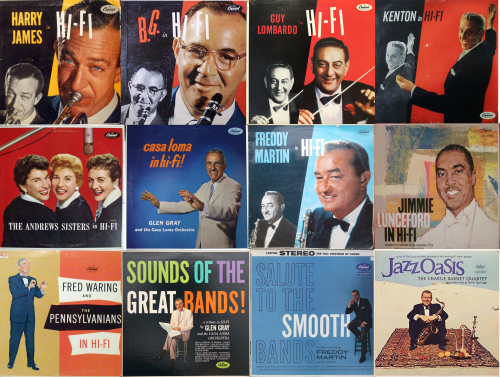
A selection of album covers from Capitol Records between 1955-1961 of artists and bandleaders re-performing their hits in newly recorded hi-fi and stereo. Note the similarities in cover designs.
The end of the war brought changing tastes, but also new technology. The newly invented vinyl long-playing record (LP) could hold up to 22 minutes of uninterrupted music per side compared to the standard shellac 78′s 3 minutes per side. Then came the advent of the stereo record where stereophonic sound could come out of two speakers at the same time to give the feeling of hearing a live orchestra right in your living room.
Trying to capitalize on the new stereo music invention, Capitol Records invited bandleaders to recreate their big bands of the 1930s and 1940s in hi-fi and in stereo. Dozens of freshly manufactured multi-track tape recorders whirled (a far cry from recording on wax discs to make masters) and took down the hits of Harry James, Benny Goodman, Guy Lombard, Stan Kenton, Glen Gray, Freddy Martin, Fred Waring, Charlie Barnett and many others. 20 years later and their hits would have that fresh new stereo sound.
To the modern ear, this early stereo effect can be off-putting and exaggerated with instruments on one side and vocals on the other. Recording in stereo was still in its infancy and the novelty was often too great to pass up.
In 1961, Capitol approached Kay Kyser for a new album. He declined after having being out of the music business for 10 years, but did not object to former members bringing the band back together.
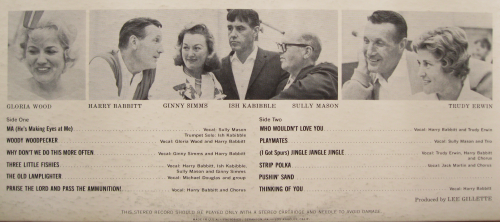
Photos from the recording session from the back cover, left to right: Gloria Wood, Harry Babbitt, Ginny Simms, Ish Kabibble, Sully Mason, Trudy Erwin.
And so, Babbitt, Michael Douglas, Erwin, Ish, Jack Martin, Mason, Simms, and Wood rejoined in the famed recording studios at the Capitol Records building on Hollywood and Vine for several sessions in August and September of 1961.
Though not all of them played instruments, each lent their voices to recreate their hit songs on various tracks complete with falsetto from Ish Kabibble and Sully Mason.
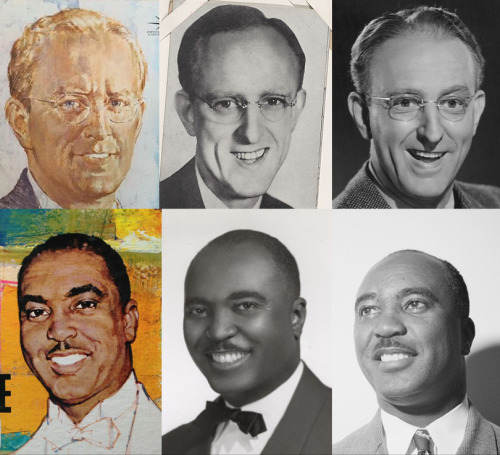
Cover art illustration for the Capitol Records albums Kay Kyser’s Greatest Hits and Jimmy Lunceford in Hi-FI by Jon Jonson. Neither were present for the recording of the new albums (Lunceford had died in 1947 following a collapse). Compared to contemporary photos of the bandleaders, perhaps Mr. Jonson has stylized the covers a bit with cleft chins. Billy May also recreated the orchestra for the Lunceford album.
For this Kay Kyser album, famed Capitol arranger Billy May is believed to have conducted the orchestra for this presumably filled with more session musicians to fill out the big band.
He is uncredited on the sleeve. The Lunceford album also moved his conducting credit to the back cover.
The track listing for the album is as follows with the addition of the original recording dates:
Side One:
Ma (He’s Making Eyes at Me) [Columbia 35411, 1940]
Woody Woodpecker [Columbia 38197, 1948]
Why Don’t We Do This More Often [Columbia 36253, 1941]
Three Little Fishies [Brunswick 8358, 1939]
The Old Lamplighter [Columbia 37095, 1946]
Praise the Lord and Pass the Ammunition! [Columbia 36640 , 1942]
Side Two:
Who Wouldn’t Love You [Columbia 36526, 1942]
Playmates [Columbia 35375, 1940]
(I Got Spurs) Jingle Jangle Jingle [Columbia 36604, 1942]
Strip Polka [Columbia 37962, 1947]
Pushin’ Sand [Columbia 36676, 1942]
Thinking of You [Columbia 36106/Brunswick 8320, 1939]
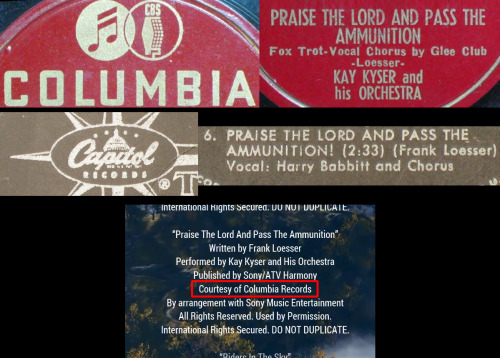
As Columbia Records retains the bulk of the Kay Kyser catalog, it is curious that the end credits for Fallout 76 mention using the Columbia version even though other Capitol Records songs have been licensed. Perhaps the licensing fees are going to the wrong company for the wrong version.
As for differences between the Capitol and Columbia
versions the overall tone is different in a way that’s admittedly hard to describe. Perhaps on the phrase “…son of a gun of a gunner was he. Shouting…”, in the original 1942 Columbia version the line is shouted loudly, but the 1962 Capitol Records version rather weakly shouts “shouting” in comparison with the male voices almost doing a voice crack.
For the track on “Praise the Lord and Pass the Ammunition” Harry Babbitt is credited this time as the lead vocal
role, perhaps weakly shouting. In general, the entire song is sung as a chorus. Ish Kabibble (trumpet), Jack Martin, and Sully Mason (saxophones)
are also present on both recordings serving double duty on instruments
and vocals as needed.
Trudy Erwin was also present at
the original July 31, 1942 recording session.
Michael Douglas,
Ginny Simms, and Gloria Wood were not at the 1942 recording session, but
had sung with the Kay Kyser orchestra on other sessions and likely
provided the backing vocals on this Capitol Records session as it is a rather loud track.
Kay Kyser himself is not present. While Stan Freberg did imitations of the “Ol’ Professor’s” voice for this record, he did not make an introduction for this track.

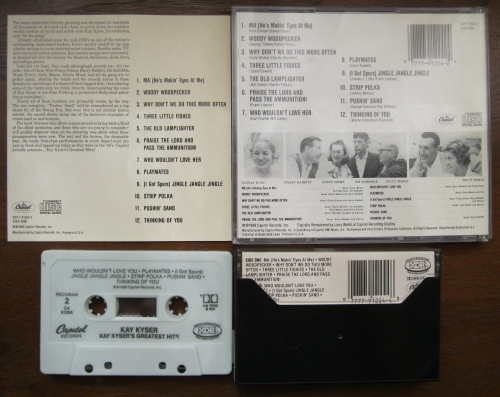
There is unfortunately very little else about the recording session that seems to have survived. In an interview with Harry Babbitt’s son, Chris, he recalled attending several of the recording sessions and recognizing more former band members, but he was too young to remember their names.
The album was indifferently reissued in 1989 on cassette tape and CD.
The liner notes are more or less an exact copy of those found on the LP. The cover art was not modified to fit the cassette box. Both the CD and the cassette retain the extreme hard panning of the instruments. However, most of Stan Freberg’s song introductions have been removed and he no longer calls the vocalists by name in an imitation of Kay Kyser.
Listen to the original 1942 recording of “Praise the Lord and Pass the Ammunition!” here.
 deepest-dope liked this
deepest-dope liked this  taakofromtv liked this
taakofromtv liked this flommischen reblogged this from rapturerecords
 redraven123 liked this
redraven123 liked this theoddsideofme liked this
rapturerecords posted this
